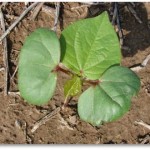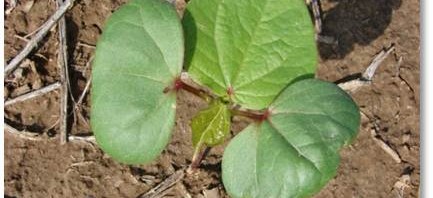 Many acres of cotton were planted in the 3-4 days prior to last Friday’s rain event followed by cold temperatures. Seedling cotton is sensitive to cold temperatures and excessive rainfall or flooding. Cotton seed exposed to temperatures below 41F can result in seedling death. Even extended exposure to temperatures below 50F can lead to radical (root) abortion, or loss of taproot. Possibly the worst scenario is when cotton is exposed to cold water during the first few hours of imbibition (absorbing water). This would be of concern for cotton planted last Thursday (5/12). A second period of concern would be for cotton planted on Wednesday where soil moisture and temperatures were excellent for germination, but increasing susceptibility to soil crusting from heavy rain prior to emergence. Finally, cotton that is in ‘early crook’ stage (just beginning to emerge from the soil) can be sensitive to chilling temperatures that were predicted for Sunday and Monday night. The good news is that we had several days of high 80F days last week to warm the soil and help provide some ‘thermal’ protection from chilling with the warm soil temperatures.
Many acres of cotton were planted in the 3-4 days prior to last Friday’s rain event followed by cold temperatures. Seedling cotton is sensitive to cold temperatures and excessive rainfall or flooding. Cotton seed exposed to temperatures below 41F can result in seedling death. Even extended exposure to temperatures below 50F can lead to radical (root) abortion, or loss of taproot. Possibly the worst scenario is when cotton is exposed to cold water during the first few hours of imbibition (absorbing water). This would be of concern for cotton planted last Thursday (5/12). A second period of concern would be for cotton planted on Wednesday where soil moisture and temperatures were excellent for germination, but increasing susceptibility to soil crusting from heavy rain prior to emergence. Finally, cotton that is in ‘early crook’ stage (just beginning to emerge from the soil) can be sensitive to chilling temperatures that were predicted for Sunday and Monday night. The good news is that we had several days of high 80F days last week to warm the soil and help provide some ‘thermal’ protection from chilling with the warm soil temperatures.
Heavy rainfall reduces soil oxygen content, increases pressure from seedling disease pathogens, and can cause soil crusting. Waterlogged conditions for 24 to 36 hours will prevent a supply of oxygen to the root system. After 36 hours of waterlogged conditions roots may die leading to the death of seedling plants. With our no-till acres, heavy rainfall can move residue back over planted rows or up against cotton seedlings. Both of these situations can cause disease present on the residue to be transmitted directly to the cotton seedlings. Typically, this will show up as disease ‘hot spots’ where water flow across the field moved residue. Soil crusting is always a concern when rain is received prior to cotton emergence. Many producers use a hill drop planting pattern to allow multiple seed to ‘push’ up the soil during germination. Pay particular attention to fields planted on 5/12 or later where a hill drop pattern was not used. As long as the soil does not dry out too quickly (warm temperatures, lots of sun and drying winds) emergence will only be impacted in wet areas of the field.
Remember that cotton does not grow with temperatures below 60F. Cotton planted late last week will be slow to emerge, and cotton that emerged last week will be slow to grow off until warm temperatures return. For some producers replant decisions will need to made quickly. For other producers the decision to make a first planting will need to be made quickly. Based on UT planting date research we are currently losing 8-10 pounds of lint per day of delayed cotton planting . Starting on May 20th we will lose 16-18 pounds per day of delayed planting, and after June 1st we lose 27-29 pounds per day of delay. For those making replant decisions a UNIFORM population of 1 plant per row foot planted on May 12th will yield as well or better than 3 plants per row foot planted on June 1st. The key to all replant decisions is the uniformity if the stand. If the stand is uniform with a low population it is worth keeping. If the stand is not uniform (many large skips of two feet or more) a replant will be required. If the stand is lost to disease from washing residue or wet soils, be sure to use a fungicide seed treatment on the replant seed since there will be high disease pressure remaining in the field.
Please contact your consultant, local county Extension Agent, retail outlet, or me if questions arise around replant decisions. Most cotton seed companies have replant policies in effect when you purchase your seed. Contact your seed sales representative to find out details of these replant programs.



Chris due to cotton being booked by the bale vs. by the acre as in past years grower will be forced to plant cotton in areas affected by flooding well into June. Give us some tips on methods to maximize yield under these conditions. Plant population, hill drop vs spacing, nitrogen rates, termination of irrigation, importance of setting early fruit anything you can think of that might get us out of a bind.
Steve, I have posted an article at http://www.utcrops.com/news/2011/05/managing-late-planted-cotton/ about managing late planted cotton. Keep the questions and comments coming. We have a long way to go this year.
Chris -What are the fungicides that should be used in replant situations?
Sam
Seed treatment fungicides such as Dynasty or Trilex are the best options. You can also use Ridomil Gold PC as a granular in-furrow treatment if you boxes on your planter to apply granules.